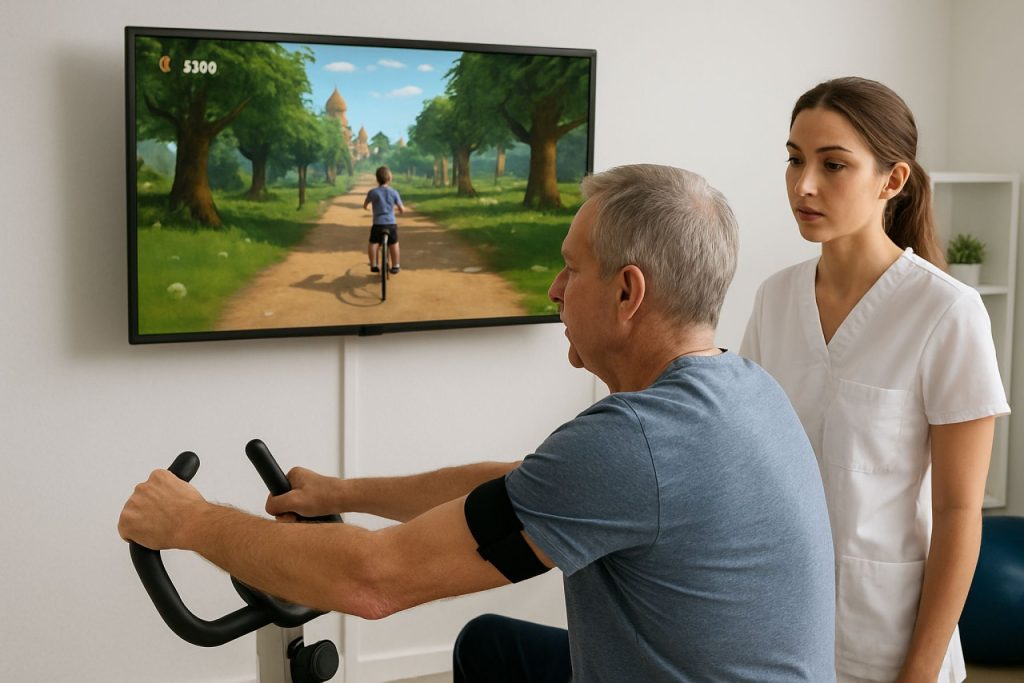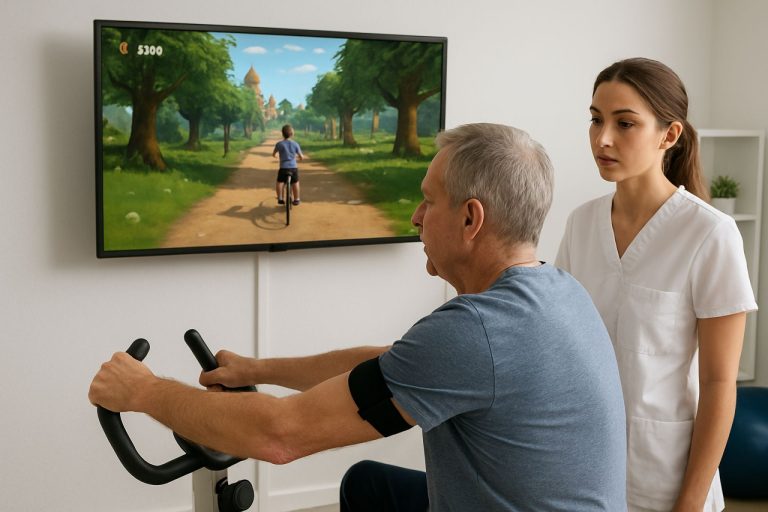
Exergaming Rehabilitation Systems in 2025: How Gamified Therapy Is Transforming Patient Outcomes and Shaping the Future of Digital Health. Explore the Innovations, Market Growth, and Strategic Shifts Driving This Dynamic Sector.
- Executive Summary: Key Trends and Market Drivers in 2025
- Market Size, Growth Forecast (2025–2030), and CAGR Analysis
- Technological Innovations: AI, VR, and Sensor Integration
- Leading Companies and Strategic Partnerships
- Clinical Efficacy and Patient Engagement Outcomes
- Regulatory Landscape and Reimbursement Trends
- Adoption Across Healthcare Settings: Hospitals, Clinics, and Home Use
- Regional Market Dynamics: North America, Europe, Asia-Pacific, and Beyond
- Challenges, Barriers, and Risk Factors
- Future Outlook: Emerging Opportunities and Next-Gen Exergaming Solutions
- Sources & References
Executive Summary: Key Trends and Market Drivers in 2025
Exergaming rehabilitation systems—technologies that combine exercise with interactive gaming—are poised for significant growth and transformation in 2025 and the coming years. These systems are increasingly recognized for their ability to enhance patient engagement, improve adherence to rehabilitation protocols, and deliver measurable clinical outcomes across a range of conditions, including stroke, musculoskeletal injuries, and neurological disorders.
A key trend driving the sector is the integration of advanced motion tracking and real-time feedback, enabled by sensors, cameras, and artificial intelligence. Companies such as Motek Medical (a part of DIH) are at the forefront, offering sophisticated platforms like the CAREN system, which combines virtual reality (VR) with biomechanical analysis for immersive rehabilitation experiences. Similarly, MindMaze leverages neurotechnology and gamified digital therapy to support neurorehabilitation, with its MindMotion suite deployed in clinics worldwide.
The adoption of exergaming is further accelerated by the proliferation of consumer-grade VR and motion-sensing devices, making home-based rehabilitation more accessible. Motek Medical and MindMaze are joined by companies like Mira Rehab, whose MIRA software transforms standard physical therapy exercises into interactive games, compatible with widely available hardware such as Microsoft Kinect and tablets. This democratization of technology is expected to drive double-digit market growth rates through 2025, as healthcare providers seek scalable, cost-effective solutions for aging populations and chronic disease management.
Another notable driver is the increasing body of clinical evidence supporting exergaming’s efficacy. Rehabilitation centers and hospitals are reporting improved patient motivation and functional outcomes, leading to broader institutional adoption. Regulatory bodies in North America, Europe, and Asia-Pacific are also beginning to recognize digital therapeutics, paving the way for reimbursement and integration into standard care pathways.
Looking ahead, the next few years will likely see further convergence between exergaming, telehealth, and data analytics. Companies are investing in cloud-based platforms for remote monitoring and personalized therapy adjustment, as well as partnerships with healthcare systems to validate and scale their solutions. The sector’s outlook remains robust, with ongoing innovation expected to expand the range of treatable conditions and further embed exergaming rehabilitation systems into mainstream healthcare delivery.
Market Size, Growth Forecast (2025–2030), and CAGR Analysis
The global market for exergaming rehabilitation systems is poised for robust growth between 2025 and 2030, driven by increasing demand for innovative, technology-driven rehabilitation solutions in both clinical and home settings. Exergaming—integrating exercise with interactive gaming—has gained significant traction as a tool for physical therapy, neurological rehabilitation, and elderly care, leveraging motion-sensing technologies and immersive environments to enhance patient engagement and outcomes.
As of 2025, the exergaming rehabilitation systems market is estimated to be valued at approximately USD 1.2–1.5 billion, with North America and Europe representing the largest regional markets due to advanced healthcare infrastructure, high adoption of digital health technologies, and supportive reimbursement policies. Asia-Pacific is expected to witness the fastest growth, propelled by expanding healthcare access, rising geriatric populations, and increasing investments in digital health.
Key industry players are shaping the market landscape through continuous innovation and strategic partnerships. Nintendo remains a prominent force, with its motion-based platforms such as the Nintendo Switch and legacy systems like the Wii, which have been widely adopted in rehabilitation settings for their accessibility and engaging content. Motek Medical, a subsidiary of DIH, specializes in advanced rehabilitation solutions that combine virtual reality and motion capture, targeting both clinical and research applications. MindMaze is another notable company, offering neurorehabilitation platforms that integrate exergaming with real-time feedback and data analytics to support recovery from stroke and other neurological conditions.
The compound annual growth rate (CAGR) for the exergaming rehabilitation systems market is projected to range between 12% and 15% from 2025 to 2030. This growth is underpinned by several factors: the rising prevalence of chronic diseases and mobility impairments, increasing awareness of the benefits of gamified rehabilitation, and the ongoing integration of artificial intelligence and remote monitoring capabilities into exergaming platforms. Furthermore, the COVID-19 pandemic has accelerated the adoption of tele-rehabilitation and home-based exergaming solutions, a trend expected to persist as healthcare systems prioritize flexible, patient-centered care models.
Looking ahead, the market outlook remains highly favorable. Industry leaders are expected to expand their product portfolios with more personalized, data-driven exergaming experiences, while collaborations with healthcare providers and insurers will likely enhance market penetration. Regulatory support for digital therapeutics and growing clinical evidence supporting exergaming’s efficacy will further solidify its role in modern rehabilitation paradigms.
Technological Innovations: AI, VR, and Sensor Integration
Exergaming rehabilitation systems are undergoing rapid transformation in 2025, driven by the convergence of artificial intelligence (AI), virtual reality (VR), and advanced sensor technologies. These innovations are reshaping how physical therapy and rehabilitation are delivered, making interventions more engaging, personalized, and data-driven.
AI is at the forefront of this evolution, enabling real-time analysis of patient movements and adaptive feedback. Systems now leverage machine learning algorithms to tailor exercise regimens to individual needs, track progress, and predict recovery trajectories. For example, Philips integrates AI-powered analytics into its rehabilitation platforms, allowing clinicians to monitor patient performance remotely and adjust therapy plans dynamically. Similarly, Samsung Electronics is investing in AI-driven health solutions that incorporate motion tracking and personalized coaching, enhancing the efficacy of exergaming interventions.
Virtual reality is another transformative force, providing immersive environments that motivate patients and simulate real-world scenarios. VR-based exergaming systems, such as those developed by HTC through its VIVE platform, are being adopted in rehabilitation clinics to improve balance, coordination, and cognitive function. These systems offer customizable experiences that can be adjusted for different patient populations, from stroke survivors to individuals with musculoskeletal injuries. The use of VR not only increases patient engagement but also allows therapists to collect granular data on movement patterns and therapy adherence.
Sensor integration is central to the accuracy and effectiveness of exergaming rehabilitation. Wearable sensors, pressure mats, and motion capture cameras are now standard components, providing real-time biomechanical data. Companies like Xsens Technologies specialize in 3D motion tracking solutions that are being incorporated into exergaming platforms for precise assessment and feedback. These sensors enable objective measurement of range of motion, gait, and posture, supporting evidence-based clinical decisions.
Looking ahead, the next few years are expected to see further integration of these technologies, with cloud connectivity and interoperability becoming standard. Major players such as Microsoft are advancing cloud-based health platforms that facilitate remote monitoring and tele-rehabilitation, expanding access to high-quality care. The combination of AI, VR, and sensor data is anticipated to drive the development of fully adaptive, home-based exergaming systems, supporting the global trend toward personalized and decentralized rehabilitation.
Leading Companies and Strategic Partnerships
The exergaming rehabilitation systems sector in 2025 is characterized by a dynamic landscape of leading companies and a surge in strategic partnerships aimed at integrating advanced technologies into clinical and home-based rehabilitation. The convergence of motion tracking, virtual reality (VR), and artificial intelligence (AI) has prompted established medical device manufacturers and innovative startups to collaborate, accelerating the development and deployment of exergaming solutions.
Among the most prominent players, Philips continues to expand its digital health portfolio, leveraging its expertise in connected care and patient monitoring to support rehabilitation platforms that incorporate gamified exercise. Philips has been actively exploring partnerships with rehabilitation clinics and technology providers to enhance patient engagement and outcomes through interactive exergaming modules.
Another key company, Hocoma, a subsidiary of DIH, is recognized for its robotic and sensor-based rehabilitation devices. Hocoma’s solutions, such as the Armeo and Lokomat systems, are increasingly integrating exergaming elements to motivate patients and provide real-time feedback. The company has established collaborations with academic institutions and healthcare networks to validate and refine its gamified rehabilitation protocols.
In the VR and motion capture domain, HTC VIVE has emerged as a significant technology partner for exergaming rehabilitation developers. Its VR hardware is being adopted in clinical settings for immersive therapy experiences, and HTC VIVE has entered into partnerships with digital health startups to co-develop rehabilitation content tailored for neurological and musculoskeletal conditions.
Meanwhile, Motek, also part of DIH, specializes in advanced movement analysis and rehabilitation systems. Motek’s platforms are frequently used in conjunction with exergaming software, and the company is actively pursuing joint ventures with software developers to expand its therapeutic offerings.
Strategic alliances are also being forged between exergaming system providers and healthcare delivery organizations. For example, several rehabilitation hospitals in Europe and North America have announced pilot programs with leading exergaming companies to assess the impact of these systems on patient adherence and recovery metrics. These partnerships are expected to yield valuable data and drive further adoption in the coming years.
Looking ahead, the exergaming rehabilitation market is poised for continued growth, with leading companies intensifying their focus on interoperability, remote monitoring, and AI-driven personalization. The next few years will likely see deeper integration of exergaming platforms into mainstream rehabilitation protocols, supported by ongoing collaborations between technology innovators, healthcare providers, and device manufacturers.
Clinical Efficacy and Patient Engagement Outcomes
Exergaming rehabilitation systems, which integrate physical exercise with interactive digital gaming, have gained significant traction in clinical settings as of 2025. These systems are increasingly recognized for their dual capacity to enhance patient engagement and deliver measurable therapeutic outcomes across a range of rehabilitation contexts, including stroke recovery, orthopedic rehabilitation, and neurological disorders.
Recent clinical deployments have demonstrated that exergaming platforms can improve adherence to rehabilitation protocols, a persistent challenge in traditional therapy. For example, systems such as the Nintendo Switch with its Ring Fit Adventure and the Microsoft Xbox Kinect have been adapted for use in physical therapy, offering motion-tracking and real-time feedback that encourage patients to complete prescribed exercises. These consumer-grade platforms are complemented by specialized medical exergaming solutions, such as those developed by Motek Medical and Tyromotion, which provide advanced motion analysis and customizable therapy modules tailored to clinical needs.
Data from recent multi-center trials and hospital deployments indicate that exergaming can lead to statistically significant improvements in motor function, balance, and cognitive engagement compared to conventional therapy alone. For instance, rehabilitation centers utilizing Tyromotion’s Amadeo and Pablo systems have reported higher patient motivation scores and increased session completion rates, particularly among elderly and pediatric populations. These outcomes are attributed to the gamified nature of the exercises, which transform repetitive movements into engaging challenges, thereby reducing dropout rates and enhancing neuroplasticity through increased repetition and feedback.
Patient engagement metrics are also being closely monitored through integrated analytics dashboards, a feature now standard in many exergaming systems. Companies like Motek Medical offer cloud-based platforms that allow therapists to track progress, adjust difficulty levels, and personalize therapy plans based on real-time performance data. This data-driven approach is expected to further improve clinical outcomes by enabling adaptive interventions and remote monitoring, a trend accelerated by the ongoing expansion of telehealth services.
Looking ahead, the next few years are likely to see broader adoption of exergaming rehabilitation systems, driven by continued technological advancements, growing clinical evidence, and increasing demand for patient-centered care. Integration with wearable sensors and artificial intelligence is anticipated to further refine outcome measurement and personalization, positioning exergaming as a cornerstone of modern rehabilitation practice.
Regulatory Landscape and Reimbursement Trends
The regulatory landscape for exergaming rehabilitation systems is evolving rapidly as these technologies gain traction in clinical and home-based therapy settings. In 2025, regulatory agencies are increasingly recognizing exergaming platforms as legitimate medical devices, provided they meet stringent safety, efficacy, and data privacy standards. The U.S. Food and Drug Administration (FDA) continues to play a pivotal role, classifying many exergaming rehabilitation systems as Class II medical devices, which require premarket notification and adherence to quality system regulations. The FDA’s Digital Health Center of Excellence has been instrumental in providing guidance for digital therapeutics, including exergaming, ensuring that new products align with regulatory expectations for software as a medical device (SaMD) (U.S. Food and Drug Administration).
In the European Union, the Medical Device Regulation (MDR) framework, fully enforced since 2021, remains the primary regulatory pathway for exergaming systems. Companies must demonstrate clinical evidence and robust post-market surveillance to achieve CE marking. The MDR’s focus on software and connected devices has prompted exergaming developers to invest in cybersecurity and interoperability features. Organizations such as Philips and Sony, both active in digital health and interactive technologies, are adapting their compliance strategies to meet these evolving requirements.
Reimbursement trends are also shifting in favor of exergaming rehabilitation. In the United States, the Centers for Medicare & Medicaid Services (CMS) have begun to recognize certain digital therapeutics and remote therapeutic monitoring (RTM) codes, which can apply to exergaming platforms that provide quantifiable patient data and clinical oversight. This has encouraged healthcare providers to integrate exergaming into physical therapy regimens, especially for stroke, Parkinson’s disease, and orthopedic rehabilitation. Companies like Motek Medical and Rehametrics are working closely with payers and providers to validate outcomes and support reimbursement claims.
Looking ahead, the next few years are expected to bring further harmonization of regulatory standards across major markets, with increased emphasis on real-world evidence and patient-reported outcomes. Industry bodies such as the MedTech Europe are advocating for streamlined approval processes and broader reimbursement coverage for digital rehabilitation tools. As exergaming systems continue to demonstrate clinical value and cost-effectiveness, their integration into mainstream healthcare is likely to accelerate, supported by clearer regulatory pathways and expanding reimbursement opportunities.
Adoption Across Healthcare Settings: Hospitals, Clinics, and Home Use
Exergaming rehabilitation systems—interactive platforms that combine exercise with gaming technology—are experiencing accelerated adoption across diverse healthcare settings in 2025. These systems, which leverage motion sensors, virtual reality (VR), and real-time feedback, are increasingly integrated into hospitals, outpatient clinics, and home-based care, driven by the need for engaging, effective, and scalable rehabilitation solutions.
In hospital environments, exergaming is being incorporated into physical and occupational therapy programs to enhance patient motivation and adherence. Major medical centers are deploying systems such as the Philips Motility platform, which utilizes sensor-based tracking and gamified exercises to support post-stroke and orthopedic rehabilitation. Hospitals report improved patient engagement and measurable gains in mobility and balance, particularly among older adults and neurological patients. The integration of exergaming with electronic health records (EHRs) is also enabling therapists to monitor progress and tailor interventions more precisely.
Outpatient clinics are adopting exergaming systems to extend therapy beyond traditional modalities. Companies like Motek Medical (a division of DIH) offer advanced VR-based rehabilitation platforms that simulate real-world tasks and environments, allowing therapists to customize programs for musculoskeletal, neurological, and pediatric populations. These systems are valued for their ability to provide objective performance data and facilitate remote supervision, which is especially relevant as clinics seek to optimize resources and reach more patients.
Home-based exergaming is rapidly expanding, fueled by advances in affordable consumer hardware and telehealth integration. Platforms such as Nintendo’s Ring Fit Adventure and MindMaze’s MindMotion GO are being prescribed for home use, enabling patients to continue rehabilitation independently while remaining connected to their care teams. These solutions are particularly beneficial for individuals with chronic conditions or limited mobility, as they reduce barriers to access and support long-term adherence. Remote monitoring features allow clinicians to track compliance and outcomes, further bridging the gap between clinic and home.
Looking ahead, the adoption of exergaming rehabilitation systems is expected to deepen as healthcare providers seek cost-effective, patient-centered approaches. Ongoing collaborations between technology developers and healthcare institutions are likely to yield more personalized, data-driven solutions. Regulatory support for digital therapeutics and reimbursement models that recognize the value of remote and gamified rehabilitation will further accelerate uptake. As a result, exergaming is poised to become a standard component of rehabilitation across hospitals, clinics, and homes in the coming years.
Regional Market Dynamics: North America, Europe, Asia-Pacific, and Beyond
The global market for exergaming rehabilitation systems is experiencing dynamic regional shifts as healthcare providers, rehabilitation centers, and technology companies increasingly recognize the value of interactive, movement-based digital therapies. In 2025, North America remains a leading region, driven by robust healthcare infrastructure, high adoption of digital health technologies, and a strong presence of pioneering companies. The United States, in particular, benefits from early integration of exergaming in physical therapy and senior care, with organizations such as Motion Shadow and Cyberith developing advanced motion capture and virtual reality (VR) platforms tailored for rehabilitation. The Canadian market is also expanding, supported by government initiatives to modernize rehabilitation services and improve patient engagement through gamified solutions.
In Europe, the exergaming rehabilitation sector is marked by a collaborative approach between healthcare providers, universities, and technology firms. Countries like Germany, the United Kingdom, and the Netherlands are at the forefront, leveraging strong public health systems and research funding to pilot and scale exergaming interventions. Companies such as Motek Medical (Netherlands) and Tyromotion (Austria) are recognized for their sophisticated rehabilitation platforms that combine real-time biomechanical feedback with engaging game environments. The European Union’s emphasis on digital health transformation and cross-border research projects is expected to further accelerate adoption through 2025 and beyond.
The Asia-Pacific region is witnessing rapid growth, fueled by rising healthcare investments, increasing prevalence of chronic diseases, and a growing elderly population. Japan and South Korea are notable for their integration of robotics and exergaming in rehabilitation, with companies like CYBERDYNE (Japan) pioneering wearable exoskeletons and interactive systems for neurorehabilitation. In China, government-backed digital health initiatives and partnerships with technology giants are expanding access to exergaming solutions in both urban and rural settings. Australia is also emerging as a key market, with universities and startups collaborating to develop locally relevant exergaming platforms.
Beyond these core regions, emerging markets in Latin America and the Middle East are beginning to explore exergaming rehabilitation, often through pilot programs and partnerships with international technology providers. While infrastructure and funding challenges persist, the global outlook for exergaming rehabilitation systems remains positive. Industry leaders anticipate continued innovation in hardware, software, and data analytics, with increasing emphasis on remote and home-based rehabilitation to address the needs of aging populations and post-acute care. As regulatory frameworks evolve and clinical evidence mounts, exergaming is poised to become a standard component of rehabilitation strategies worldwide.
Challenges, Barriers, and Risk Factors
Exergaming rehabilitation systems—integrating physical exercise with interactive digital gaming—are gaining traction in clinical and home-based therapy. However, as of 2025, several challenges, barriers, and risk factors continue to shape their adoption and effectiveness.
A primary challenge remains the accessibility and affordability of advanced exergaming platforms. While consumer-grade devices such as the Nintendo Switch and its Ring Fit Adventure have made exergaming more mainstream, clinical-grade systems with validated therapeutic outcomes, such as those developed by Motek Medical and Tyromotion, often require significant investment in hardware, software, and ongoing support. This cost barrier limits widespread deployment, particularly in smaller clinics and low-resource settings.
Another significant barrier is the need for robust clinical validation. While companies like Motek Medical and Tyromotion have published data supporting the efficacy of their systems for neurological and orthopedic rehabilitation, the diversity of patient populations and conditions means that more large-scale, longitudinal studies are needed to establish standardized protocols and ensure safety across demographics. Regulatory requirements for medical devices, enforced by bodies such as the U.S. Food and Drug Administration (FDA), add complexity and can delay market entry for innovative solutions.
User engagement and adherence present ongoing risk factors. Exergaming systems rely on sustained patient motivation, yet factors such as age, cognitive ability, and digital literacy can impact usability. Companies like Nintendo and Tyromotion are investing in adaptive interfaces and gamification strategies to address these issues, but ensuring long-term engagement—especially in older adults or those with cognitive impairments—remains a challenge.
Data privacy and cybersecurity are increasingly critical as exergaming systems collect sensitive health and movement data. Manufacturers must comply with regulations such as HIPAA in the U.S. and GDPR in Europe, requiring robust encryption and secure data management. Companies like Tyromotion emphasize their commitment to data protection, but the evolving threat landscape necessitates ongoing vigilance.
Looking ahead, the sector faces the dual challenge of scaling up access while maintaining clinical rigor and user safety. Partnerships between device manufacturers, healthcare providers, and regulatory agencies will be essential to address these barriers and realize the full potential of exergaming rehabilitation systems in the coming years.
Future Outlook: Emerging Opportunities and Next-Gen Exergaming Solutions
The future of exergaming rehabilitation systems is poised for significant transformation as technological advancements and healthcare trends converge in 2025 and the coming years. Exergaming—interactive video games that require physical movement—has already established itself as a valuable tool in physical therapy, neurological rehabilitation, and geriatric care. The next generation of these systems is expected to leverage artificial intelligence, advanced motion tracking, and cloud-based analytics to deliver more personalized, adaptive, and data-driven rehabilitation experiences.
Key industry players are actively shaping this landscape. Nintendo, with its pioneering Wii Fit and Ring Fit Adventure platforms, continues to inspire new developments in motion-based rehabilitation, while also exploring partnerships with healthcare providers to validate clinical outcomes. Microsoft’s Azure Kinect platform, originally developed for gaming, is now being integrated into rehabilitation solutions for its precise skeletal tracking and real-time feedback capabilities. These systems are increasingly being adopted in clinics and home settings, enabling remote monitoring and tele-rehabilitation—an area that has seen accelerated growth post-pandemic.
Emerging companies such as Motek Medical (a division of DIH) are pushing the boundaries with immersive virtual reality (VR) and augmented reality (AR) exergaming systems. Their solutions combine biomechanical analysis with interactive environments, allowing therapists to tailor exercises to individual patient needs and track progress with high granularity. Similarly, Rehametrics is developing cloud-based rehabilitation platforms that use gamified exercises and AI-driven analytics to optimize therapy regimens and improve patient engagement.
Looking ahead, the integration of wearable sensors and Internet of Things (IoT) devices is expected to further enhance exergaming rehabilitation. Companies like Philips are exploring connected health solutions that can seamlessly collect physiological data during exergaming sessions, providing clinicians with actionable insights and enabling real-time adjustments to therapy plans. The adoption of 5G connectivity will also facilitate high-quality, low-latency remote sessions, making advanced rehabilitation accessible to a broader population.
Industry bodies such as the American Hospital Association are advocating for the integration of digital therapeutics, including exergaming, into standard care pathways. As regulatory frameworks evolve and reimbursement models adapt, the exergaming rehabilitation sector is expected to see increased investment and rapid innovation. By 2025 and beyond, these advancements are likely to result in more effective, engaging, and widely accessible rehabilitation solutions, ultimately improving patient outcomes and reducing healthcare costs.
Sources & References
- Motek Medical
- Nintendo
- Philips
- HTC
- Xsens Technologies
- Microsoft
- Hocoma
- HTC VIVE
- Tyromotion
- Rehametrics
- Motion Shadow
- Cyberith
- CYBERDYNE
- American Hospital Association



